
things to see & do
Argyll & Beyond
The Galley of Lorne Inn is ideally situated to explore the West Coast of Scotland. Not too far north to explore the Kintyre peninsula and not too far south to explore Glencoe and Fort William. Of course there are a plethora of wonderful locations, gardens, castles, towns and villages within very easy reach. A week would be no where enough time to see everything within an easy drive.
One of the many positive comments we get from guests is about our comprehensive guest information folder in their rooms. It has been said on many occasions, “the most comprehensive they have ever seen in a hotel”, so why shouldn’t it be the same for our website?
Whether it be to the north to Fort William and the mountains of the Nevis range or breathtaking Glencoe, or southwards towards Dunoon or Campbeltown and the stunning Mull of Kintyre, or even eastward and inland towards central Scotland, all can be achieved in a comfortable day trip with The Galley of Lorne Inn being your ideal base.
Nonetheless, if staying local is your want and desire, then we do have the Corryvreckan on our doorstep (the third largest whirlpool in the world), historic Kilmartin Glen with it’s standing stones, cup rings and cairns, and Dunadd, the ancient capital of the Kingdom of Dalriada (500AD) all within very easy reach of our Inn. The area where Ardfern is located is known as the cradle of Scottish Christianity! Travelling further a field, but still within easy reach, is a plethora of other attractions including plenty of National Trust buildings and gardens. The list is endless.
Lest it be forgotten that this is only a visitors guide that touches the surface. Afterall, on any trip you are likely to discover a multitude of pretty villages and stunning vistas at each and every turn. Please take your time to look through our comprehensive tourist guide and see for yourself why The Galley of Lorne Inn is about as perfect a location as can be in Scotland to explore the west coast.
Whether it be to the north to Fort William and the mountains of the Nevis range or breathtaking Glencoe, or southwards towards Dunoon or Campbeltown and the stunning Mull of Kintyre, or even eastward and inland towards central Scotland, all can be achieved in a comfortable day trip with The Galley of Lorne Inn being your ideal base.
Nonetheless, if staying local is your want and desire, then we do have the Corryvreckan on our doorstep (the third largest whirlpool in the world), historic Kilmartin Glen with it’s standing stones, cup rings and cairns, and Dunadd, the ancient capital of the Kingdom of Dalriada (500AD) all within very easy reach of our Inn. The area where Ardfern is located is known as the cradle of Scottish Christianity! Travelling further a field, but still within easy reach, is a plethora of other attractions including plenty of National Trust buildings and gardens. The list is endless.
Lest it be forgotten that this is only a visitors guide that touches the surface. Afterall, on any trip you are likely to discover a multitude of pretty villages and stunning vistas at each and every turn. Please take your time to look through our comprehensive tourist guide and see for yourself why The Galley of Lorne Inn is about as perfect a location as can be in Scotland to explore the west coast.
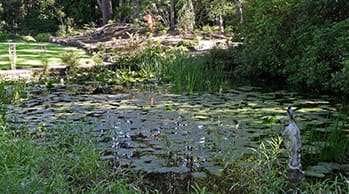
Arduaine Gardens
6 Miles from Ardfern
- Arduaine is best known for the wonderful collection of rhododendrons which has been built up here over a period of eighty or ninety years, including many tender species and hybrids which flourish in our moist, mild climate. Situated on a south-facing slope overlooking Asknish Bay and the Sound of Jura, this sheltered 20-acre garden is home to a diversity of plants from all over the world, both well known and unfamiliar. From great trees to homely herbaceous borders, from magnificent shrubs to delicate water lilies, from moss-covered rocks to sweeping lawns, Arduaine provides the discerning visitor with something of interest at all times of the year. A garden of quiet charm, Arduaine is in the care of the National Trust for Scotland.
- TEL: + 44 (0) 1852 200366
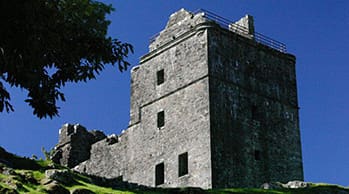
Carnasserie Castle
7 Miles from Ardfern
- Built between 1565 and 1572 on the site of an older building, Carnasserie Castle is on a ridge above the Kilmartin valley. The car park is just off the main A816 road, heading towards Oban, so visitors have a climb up a pathway to reach the castle itself.
- Carnasserie was built by John Carswell who became Bishop of Argyll and the Isles in the reign of Mary Queen of Scots. He translated John Knox's "Liturgy" into Gaelic which became the first book ever printed in Scots Gaelic. Carswell held the lands and the castle on behalf of Archibald Campbell, the 5th Earl of Argyll. A motto above a doorway reads " God be with O Duibhne" - the archaic name for the chiefs of the Campbells of Argyll. The panel also contains the Earl's coat of arms as well as the royal arms - the Earl of Argyll married a daughter of King James V. The Earl took over the castle on Carswell's death in 1572. It is now owned by Historic Scotland.
- The castle was badly damaged by the MacLeans and MacLachlans when the 9th Earl of Argyll took part in the Monmouth Rising, a rebellion against King James VII in 1685. Nevertheless, there are still fine stone carvings and a magnificent fireplace to be seen.
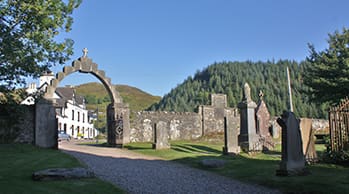
Kilmartin
8 Miles from Ardfern
- The Kilmartin Valley (Glen) is an area of enormous archaeological significance. There are more than 350 ancient monuments within a 6-mile radius of Kilmartin, and 150 of those are prehistoric, including standing stones, stone circles, cairns and chambered tombs, some of the relics dating back 5000 years.
- Kilmartin House Museum of Ancient Culture is a well known Archaeological museum. Here you will find fantastic modern audio-visual and interactive displays. Kilmartin, Argyll, PA31 8RQ. Telephone: 01546 510330.
- Carnasserie Castle Ruin is in Kilmartin. Built between 1565 and 1572 on the site of an older building, Carnasserie Castle is on a ridge above the Kilmartin valley. The car park is just off the main A816 road, heading towards Oban, so visitors have a climb up a pathway to reach the castle itself.
- Carnasserie was built by John Carswell who became Bishop of Argyll and the Isles in the reign of Mary Queen of Scots. He translated John Knox's "Liturgy" into Gaelic which became the first book ever printed in Scots Gaelic. Carswell held the lands and the castle on behalf of Archibald Campbell, the 5th Earl of Argyll. A motto above a doorway reads " God be with O Duibhne" - the archaic name for the chiefs of the Campbells of Argyll.
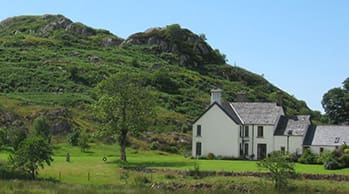
Dunadd
12 Miles from Ardfern
- It is difficult to believe today, but between AD500 and 900 this was one of the most important places in Scotland.
- The original Scots were migrants from Ireland who from about 500 settled across Argyll in ever greater numbers, founding the Kingdom of Dalriada. Dunadd was the capital of the Kingdom and where its Kings were anointed.
- From this foothold the Scots eventually incorporated their much longer-standing neighbours the Picts. By 843 Kenneth MacAlpin, King of the Scots of Dalriada, had also become King of the Picts. By 850 pressure from Viking raids caused the conjoined Kingdom of Alba to move its centre from Dunadd to Scone, near Perth. Dunadd's days of glory were over.
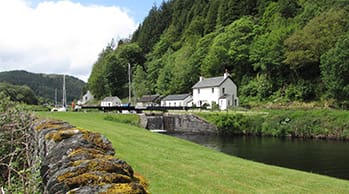
Cairnbaan
14 Miles from Ardfern
- Situated on the Crinan Canal, the village of Cairnbaan lies 2 miles (3 km) north west of Lochgilphead in Argyll and Bute.
- There are nine locks along the Canal at Cairnbaan. A mile (1½ km) to the east, the prehistoric rock carvings known as the Cairnbaan Cup and Ring Marks are in the care of Historic Scotland.
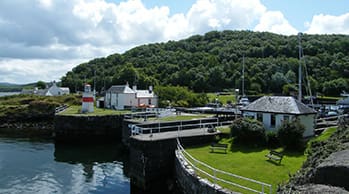
Crinan
15 Miles from Ardfern
- Revelling in the title of 'Britain's most beautiful shortcut', the Crinan Canal cuts through the Kintyre peninsula on the way to the Western Isles.
- Running for nine miles between Ardrishaig and Crinan, the canal was built to save sailing boats from the difficult passage around the Mull of Kintyre. Well used even today, the canal passes through wonderful Scottish scenery that is especially beautiful around Crinan Basin.
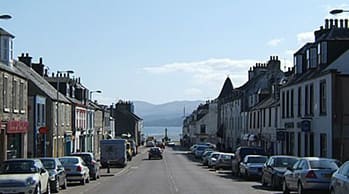
Lochgilphead
16 Miles from Ardfern
- Lochgilphead stands at the head of a short loch called Loch Gilp which leads north west from Loch Fyne. Lochgilphead is one of those rare towns that have been built according to the architect's plans. It was first laid out as a planned town in 1790, soon after the completion of the road from Inveraray to Campbeltown. Since then the town has steadily grown in its stature due to several important developments.
- During 1801, the Crinan Canal became functional providing a considerable short cut across the Kintyre peninsula. By 1830 a road was built linking Lochgilphead to Oban, and by 1831 a wooden pier was constructed thus linking Lochgilphead directly to Glasgow and other major cities. Sadly, the wooden pier is no longer any where to be seen.
- Because of its central location, Lochgilphead soon acquired its most important role as administrative headquarters for Argyll which has now expanded to include the whole of Argyll and Bute - a vast area of western Scotland.
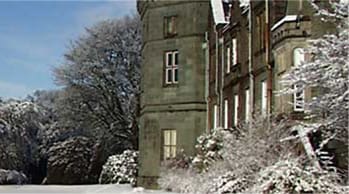
Kilmory Woodland Park
17 Miles from Ardfern
- Within the attractive grounds of Kilmory Castle, headquarters of Argyll and Bute Council stand these historic gardens which were extended by Professor Hooker in 1830.
- The gardens still retain many rare trees and shrubs including fine rhododendrons and recent restorations include herbaceous borders and collections of hardy ferns and alpines. The gardens form part of Kilmory Woodland Park which also offers a network of woodland walks linking a lochside picnic area, bird hide, superb viewpoints and archaeological sites with a year round programme of events for all the family.
- TEL: + 44 (0) 1546 602127
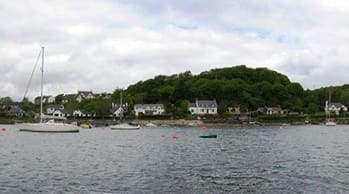
Tayvallich
19 Miles from Ardfern
- A village in Knapdale, Tayvallich ('the house in the valley') lies on Loch a'Bhealaich, a sheltered inlet on the western shore of Loch Sween. A small pier was built here in the early 19th century and the village developed in association with fishing, forestry and tourism.
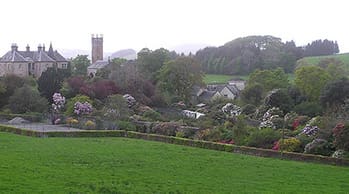
Ardmaddy Castle Garden
21 Miles from Ardfern
- Ardmaddy rises above its formal walled garden on one side with outstanding views of the Islands on the other.
- Visitors approach the garden by an old arched footbridge over a burn finding its final path to the sea. A fine collection of species and hybrid rhododendrons, azaleas and climbing plants line the walls with a continually increasing variety of shrubs and herbaceous perennials. Walks through mixed shrubs, trees and spring flowering bulbs lead on to the water gardens and up into bluebell woods among which are some fine rhododendrons more than half a century old. Recent stone and water features add a further dimension to the interest of this garden evolving in its unique setting. A wide variety of plants and vegetables in season for sale.
- TEL: + 44 (0) 1852 300353
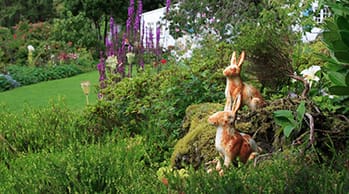
An Cala Gardens, Isle of Seil
24 Miles from Ardfern
- Designed by Mawson in the early 1930's, An Cala displays many of the rugged features typical of his style.
- Meandering streams, winding paths, formal terracing built of the local slate and wide green lawns come together to form a pleasing harmony of elements. Much of the original planting still survives in the beds of Poulsen roses, groves of Japanese cherry trees, banks of Ghent azaleas and escallonia hedges. A fifteen foot high wall of grey brick protects the garden from the worst of the Atlantic gales, while the benign effect of the Gulf Stream allows abutilons and other tender plants to survive.
- TEL: + 44 (0) 1852 300237
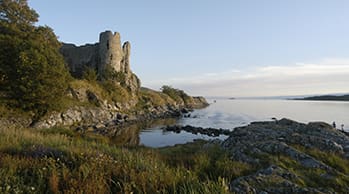
Castle Sween
24 Miles from Ardfern
- Castle Sween in Argyll is one of the oldest castles in Scotland. It was built in the 11th or 12th century, and has a curtain wall, enclosing a rectangular courtyard, and a keep. It is said to be named after Sueno, an 11th century Dane.
- He may have been the builder of the castle. It was held by the McSweens until it was captured by Robert the Bruce in 1315. It was then held by the McMillans, the Stewarts of Menteigh, the MacNeils of Gigha for the MacDonald Lord of the Isles, and in 1481 the Campbells became keepers for the Crown.
- During the time of the McMillans the western wall was dismantled and a round tower and a new rectangular building were added at the northwest corner. The tower is standing today, and is known as McMillan's Tower. The Campbells became keepers for the Crown in 1481. In 1647 it was captured and partially destroyed by Alaisdair Colkitto MacDonald. One tower collapsed in the 19th century. It has been repaired and is open to the public.
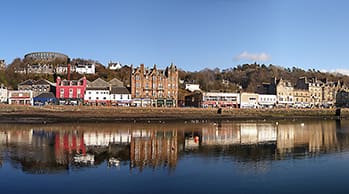
Oban
24 Miles from Ardfern
- Your first view of Oban is one you are unlikely to forget. From the north, you glimpse this bustling port from the top of the 'Bealach-an-Righ'. As you sweep down the hill towards the expanse of the bay, the view opens up before you and one begins to appreciate why Oban has developed into Scotland's most popular west-coast town.
- Beyond Oban ("little bay" in Gaelic - Scotland's ancient Celtic language) lie the islands of the Inner Hebrides: Kerrera, which protects the town from Atlantic storms, the low, green island of Lismore, majestic Mull and the granite mountains of the Morvern peninsula.
- Oban is justifiably known as the Gateway to the Isles. The town's south pier is the embarkation point for car ferries to Mull, Coll, Tiree, Barra, South Uist, Colonsay, Lismore and Islay. From these islands you can travel further afield to Iona, Staffa and to many of the smaller less well known isles.
- Oban Distillery is one of the oldest distilleries in Scotland, dating back to around 1800 it underwent refurbishment in the 1890's and there has been little change to the present buildings since then. This coastal location is accurately reflected by the character of the Oban 14 year old single malt whisky.
- Visit Oban Distillery, meet knowledgeable guides and learn about the ancient art of distilling, then enjoy a complimentary dram of the Oban 14 year old West Highland Malt.
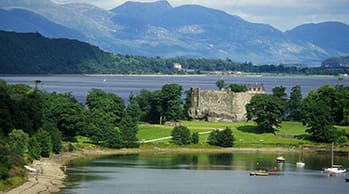
Dunstaffnage, Nr Oban
28 Miles from Ardfern
- A fine 13th-century castle, built on a rock, with nearby ruins of a chapel of exceptional architectural refinement. Flora MacDonald was imprisoned here in 1746.
- Most of the grounds and gardens are suitable for visitors using wheelchairs or with limited mobility, but the castle itself isn't. Double doors in the shop allow wheelchair access and there is adequate space in the centre for visitors using wheelchairs to view all stock.
- Large grassed areas are suitable for relaxing or picnics in a peaceful setting with a wealth of birdsong.
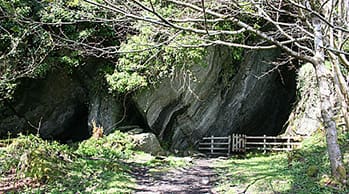
St Columba's Cave
28 Miles from Ardfern
- St Columba's Cave can be found, by those with a love of the remote, on the Knapdale Peninsula. St Columba stopped off here to meditate and minister 1400 years ago, after leaving Ulster, while he awaited permission from King Conal to establish his monastery on Iona.
- The cave has been used on and off since the middle of the Stone Age and St Columba's font is believed to have been a Stone Age mortar. Some way in, on a rock shelf to your right, is a stone altar and carved on the wall behind is a rustic, but clearly identifiable, cross.
- With Loch Caolisport sparkling to your left and the road ahead leaving the loch edge and deteriorating to a 4 wheel drive track, park and to your right just a little way from the road will be the ivy clad ruins of a 13th century chapel. If the bracken isn't winning, a path will lead through these ruins and on to the base of the cliff and the cave.
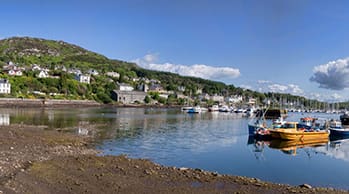
Tarbert
29 Miles from Ardfern
- Tarbert, a small fishing village well known for its seafood, sits around a natural harbour with an active fishing fleet and one of the most historic seafood festivals in the world.
- The new Kintyre Way which starts here in Tarbert is a new walk in August which spans the whole of Kintyre from the north to south across approximately 90 miles, an ideal way to see Tarbert and Kintyre.
- It has a unique maritime history as Magnus 'Barelegs', the King of Norway, had himself and his longship dragged across the land in AD 1098 to claim the Kintyre peninsula as an island and therefore a Viking possession. It stayed that way until Somerled's victory over the Vikings 60 years later. Today, Tarbert is a popular tourist destination. A recent attraction - An Tairbeart Centre - explores the heritage of this fascinating and beautiful area and is well worth visiting. A trip to nearby Saddell Abbey and Castle continues the links with Somerled. This Cistercian abbey (the only one in Argyll) was founded around AD 1160 by Somerled with Irish monks. He is reputed to be buried beneath the fine sculptured tombstones within its now ruined walls.
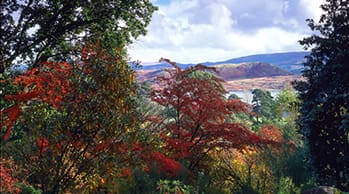
Crarae Garden
30 Miles from Ardfern
- Rare trees and exotic shrubs from around the world thrive in the mild climate and the magnificent setting of the Highland glen making Crarae unique among gardens.
- With over four hundred rhododendrons and azaleas, spring and summer abound with colour as the seasons progress. The many flowering shrubs change the garden's mood daily. Autumn is especially beautiful thanks to the superb variety of deciduous trees. Throughout the year the sheltered woodland walkways and spectacular gorge are a source of delight and inspiration. There is a visitor centre selling crafts and refreshments which is open seasonal hours.
- TEL: + 44 (0) 1546 886614
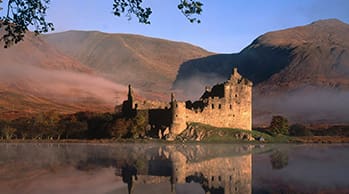
Kilchurn Castle, Loch Awe
35 Miles from Ardfern
- Now standing as a splendid ruin on a small peninsula along the marshy banks of Loch Awe, Kilchurn Castle represents 250 years of building, and a similar period of desertion. Originally built as a five storey Tower House, that still survives, largely intact, at the eastern end of the site, Kilchurn Castle was remodelled many times throughout its history.
- Sir Colin Campbell of Glenorchy first erected the Tower House c1420 and, unlike many English castles where access was often at first floor level, Kilchurn Castle was entered from the ground floor. Directly above the vaulted entrance would have been the Great Hall, with two further storeys above providing the various accommodation requirements of the castle and, at the top, a garret leading onto a parapet walk. A curtain (Barmkin) wall would have enclosed the remainder of the site, the southern section of which still survives.
- At the turn of the 16th century Kilchurn Castle was extended by Sir Duncan Campbell with the addition of a single storey dining hall built along the inside of the south curtain. During the second half of the century, another Sir Colin Campbell, the 6th Laird, continued to improve the castle's accommodation by adding some chambers to the north of the Tower House, and remodelling the parapet. This included the introduction of the circular corner turrets adorned by corbels, most of which have survived remarkably well.
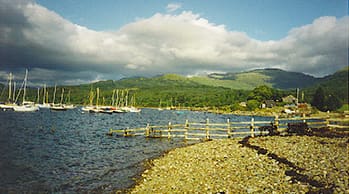
Barcaldine, Nr Oban
36 Miles from Ardfern
- The Scottish Sea Life Sanctuary offers a fascinating insight into the myriad marine marvels to be discovered beneath the seas around our own shores, providing close encounters with everything from humble shrimps to sharks and North American otters.
- Experience what a seal pup rescue is really like - through the eyes of an abandoned pup. From SOS call-out to intensive care, follow the progress of an injured pup on its fascinating road to recovery and eventual release.
- TEL: + 44 (0) 1631 720386, Website: http://www.visitsealife.com/Oban
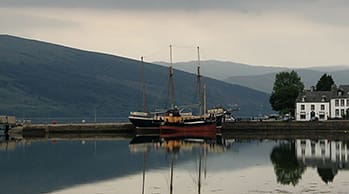
Inveraray
40 Miles from Ardfern
- Inveraray enjoys a picturesque setting on the shores of Loch Fyne, where it meets Loch Shira. It was built on the site of an earlier fishing village in the mid 1700s by the 3rd Duke of Argyll, chief of the powerful Clan Campbell. He demolished the old village to build a grand castle and rehoused the population in attractive Georgian houses on a new Main Street.
- The Duke also built a church, All Saints, in elegant neo-classical style. In consideration of local culture, it was divided into two parts so that services could be held in both English and Gaelic.
- A later addition, a memorial to the Campbells who fell in World War I, is the Bell Tower, which opens to visitors during the summer months. There are 10 bells in the Tower, reputedly the second heaviest peel in the world. The views from the top of the Tower are outstanding.
- Inveraray Jail also dates to the 3rd Duke's redevelopment of the town. The Georgian courthouse and grim prison blocks closed for use in the 1930s but have been re-opened as an imaginative visitor centre and museum. The museum tells the story of prison conditions from medieval times up to the 1800s using interactive displays and live performances. Inveraray Jail is open daily throughout the year.
- Moored at the town pier is the Arctic Penguin, a triple-masted schooner built in Dublin in 1911. Its 21st Century use is as a museum of maritime history. The Arctic Penguin is open all year.
- Telephone: + 44 (0) 1499 302203.
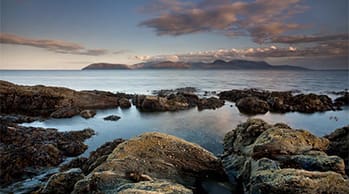
Skipness
41 Miles from Ardfern
- Skipness overlooks the Isle of Arran and is situated on the north westerley most point of Kintyre, only 13 miles from Tarbert, the gateway to Kintyre. The Kintyre Way walk also passes through Skipness with a good walk from Tarbert to Skipness which then passes on through Claonaig on its way to Clachan, Carradale, Campbeltown, Machrihanish and finally to Southend.
- Skipness is about as far from urban living as you can get with stunning countryside and amazing views across to Arran on clear bright days, the village of Skipness is small and picturesque, ideal for amateur and professional artists and photographers.
- The largely 13th Century Skipness Castle is a magnificent asset to Kintyre and remains in superb condition, free from scaffolding and free entry ensures good photographing and open access all year round.
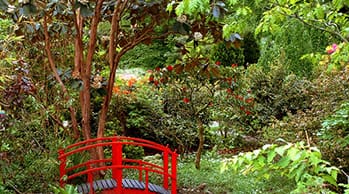
Kinlochlaich
42 Miles from Ardfern
- The walled garden commenced as a garden plant centre and nursery 20 years ago and has developed over the years to offer one of the largest selections of garden plants in Scotland.
- It has headed the list of Scotland's Best Garden Centres in the Sunday Times again, where they report that 'this delightful place is one of the attractions of the West Highlands'. It must be one of the very few centres which actually uses a garden in which to demonstrate and display plants as most garden centres are 'Shops without windows'.
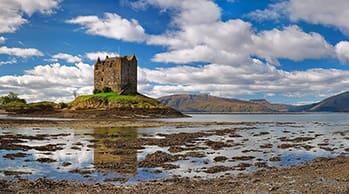
Portnacroish
43 Miles from Ardfern
- With beautiful views of Castle Stalker, Loch Linnhe and the Morvern Hills.
- Castle Stalker is one of the most photographed castles in Scotland and has a fascinating history. More recently, the castle was a backdrop for one of the scenes in Monty Python's The Holy Grail.
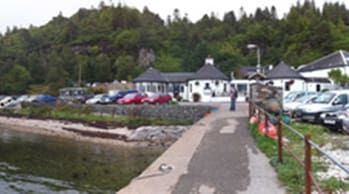
Port Appin
44 Miles from Ardfern
- Port Appin lies on the coast of Appin, just north of Loch Creran as it meets the sea. It looks directly across the strip of water called the Lynn of Lorn to the northern tip of the island of Lismore, and across Loch Linnhe to the coast of Morvern beyond.
- This is one reason why Port Appin can be a crowded place at popular times of the year. The shortest and cheapest ferry crossing to Lismore runs from the jetty here. The Lismore is a passenger-only ferry running approximately every two hours in each direction.
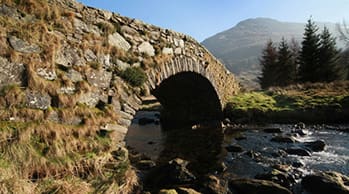
Cairndow
50 Miles from Ardfern
- Ardkinglas Woodland Garden is set on a hillside overlooking Loch Fyne and contains one of the finest collections of Conifers in the British Isles including many Champion Trees. These include the "Mightiest Conifer in Europe" dating back to 1750, Abies alba, a monstrous Silver Fir with a girth in excess of 31 feet (9.6m) which was selected as one of 50 Great British Trees to celebrate Queen Elizabeth II's Golden Jubilee.
- The Garden can be enjoyed through all the seasons but the most spectacular time is in spring and early summer when the bluebell carpet and extensive collection of Rhododendrons and Azaleas elevate the garden into a riotous display of colour. It is a garden that can be enjoyed both by the plant enthusiast and those wanting a peaceful woodland walk.
- There is also a Woodland Lochan and a Gazebo which houses a unique "Scriptorium", somewhere to sit and enjoy the view whilst contemplating the quotes. Car park, picnic area, plant & gift sales and toilet facilities are available at the Garden whilst refreshments are available at the Tree Shop nearby.
- TEL: + 44 (0) 1499 600261
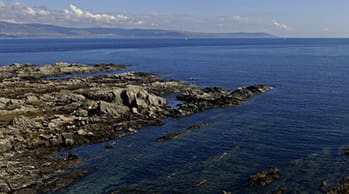
Carradale
54 Miles from Ardfern
- The village of Carradale lies a little over half-way down the east coast of the Kintyre peninsula at a point where the Kilbrannan Sound is less than three miles wide. It marks the point where the twin track road from the south becomes single track as it heads north, and much of it is actually bypassed by the B842 anyway. The result of all this is that no-one ends up in Carradale who hasn't actually set out to be there, and the village offers a gentle pace and a quiet charm that amply reflects that. The village is one of a number of reasons why you shouldn't overlook this less travelled east coast of the peninsula.
- Carradale itself is a slightly fragmented settlement which can be viewed as a number of distinct parts. The main coast road passes through what the map calls Bridgend, and here you find the petrol and police stations, a restaurant and, a little way along the B879 to the rest of the village, the parish church. Following the B879 towards the rest of the village takes you past the Carradale Network Centre, a heritage centre, on your left, while the woodland opposite conceals Carradale House and, beyond it, a caravan site overlooking Carradale Bay.
- The B879 is in total only about a mile and a half in length, and as you continue along it you pass the village hall on your right before entering the main centre of the village. Here you find a shop and post office, two hotels, a golf club, and the residential focus of the village. Continuing east brings you to a steep descent that emerges beside Carradale's harbour. Piles of nets, floats, ropes, lobster pots and assorted baskets tumble along the quay side and fishing boats jostle for position on their moorings. This is very much a working harbour. A plaque on the harbour wall pays tribute to the crew of the Carradale-based fishing vessel Antares, lost to the sea off Arran on 22 November 1990; a sobering reminder of the dangers of working these waters.
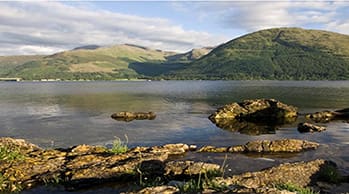
Ballachulish
57 Miles from Ardfern
- Ballachulish is a slightly confusing place. And not just because it has a name that is difficult to spell correctly, or even consistently incorrectly. It's not unusual to find places that come in two halves. But Ballachulish comes in two halves plus another, larger, settlement two miles along the road to Glencoe.
- The name comes from the Gaelic for village of the narrows, and the first settlement to bear the name lay where North Ballachulish is today. Its twin, on the south side of the loch, rapidly followed. Loch Leven narrows dramatically here and North and South Ballachulish grew up around the slipways from which a ferry crossed the loch from a very early date. A vehicle ferry started to cross the narrows in 1912, but the service finally disappeared in 1975 when the bridge opened. With it disappeared the choice facing drivers of the sometimes long queues at busy periods or the nineteen mile detour via Kinlochleven.
- Though the ferry has long gone, the slipways that served the ferry remain: by no means opposite one another. The steel truss bridge that opened here in 1975 fits nicely into its environment. Indeed, it comes as something of a surprise to find it is such a relatively recent addition to this part of the Western Highlands.
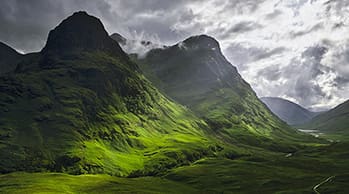
Glen Coe
58 Miles from Ardfern
- Glen Coe is a steep-sided valley climbing steadily south east from the village of Glencoe on the sea-loch, Loch Leven. It eventually emerges from its enveloping mountains onto the wet plateau of Rannoch Moor ten miles away and at an altitude of over 1000 feet.
- Glen Coe is famous for two main reasons: its topography and its history. The name probably means narrow glen and for the sheer majesty of mountain scenery there is little to beat it anywhere. The north side of the glen is closely hemmed in by the jagged edge of the Aonach Eagach ridge, usually thought to be the most challenging ridge scramble in mainland Scotland.
- The south side of lower Glen Coe revolves around the complex mountain architecture of Bidean nam Bian, a reclusive giant that keeps its summit hidden behind three huge protruding buttresses that tower over the glen. And between two of these buttresses lies the high level hidden valley of Allt Coire Gabhail, for many years used by the Glen Coe MacDonalds to hide their cattle, and anyone else's they could get their hands on.
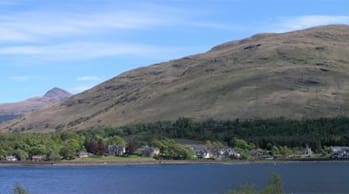
Arrochar
62 Miles from Ardfern
- Arrochar lies at the head of Loch Long, in an idyllic location that offers the best of Scotland: a sea loch surrounded by mountains, all within easy reach of Glasgow. This does mean it can be a busy place at the height of the season and at weekends, but catch it when it is a little quieter and you begin to see the plus points of somewhere that is all too often under-appreciated.
- The Arrochar Alps are a lofty range of mountains to the north of Glen Croe includes Ben Ime, the highest peak at 3,318ft. There are three other "Munroes" (mountains over 3,000ft) in this area, but the best known peak because of its curious rock formation summit, is "The Cobbler" (Ben Arthur).
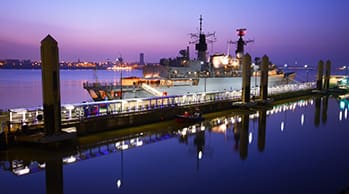
Campbeltown
66 Miles from Ardfern
- Campbeltown is the chief town and port of the Kintyre Peninsula and sits at the head of Campbeltown Loch. Local attractions include:- Davaar Island, Museum, Heritage Centre, Linda's Garden, Owl Centre, Springbank Distillery, four top golf courses, and a Bird Observatory.
- Popularly known as the 'Wee Toon', Campbeltown was a former seat of the Kings of Dalriada, the site was granted by King James V to the Campbells of Argyll who were charged with maintaining royal power and authority in this rebellious corner of Scotland. The Campbells later created Kilkerran Castle and renamed the existing small settlement Campbeltown. Lowlanders from Ayrshire and Renfrewshire settled in the town in the 17th Century, enhancing its status as a burgh of barony (1667) and a royal burgh (1700). The town developed in association with coal mining, herring fishing, boat building and whisky distilling, all of which went into decline at the beginning of the 20th Century. Of the 36 distilleries that once operated in Campbeltown, only a handful have survived. It is now an agricultural service centre and has the oldest surviving cinema in Scotland and a local museum.Campbeltown is the chief town and port of the Kintyre Peninsula and sits at the head of Campbeltown Loch.
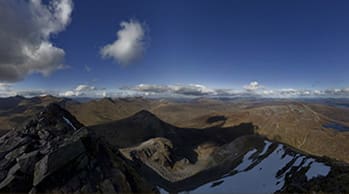
Fort William
69 Miles from Ardfern
- Fort William is the principal town in the West Highlands. It takes its name from a fort founded here in 1690 and named after William, Prince of Orange.
- As a busy centre it offers a wide range of shops and services, including major supermarkets and businesses selling outdoor and activity wear, books, tartans, tweeds, woollens and crafts, mostly along its pleasant and pedestrianised main street. Its location as a meeting-place for West Highland routes also means it has a range of pubs, places to eat and Scottish entertainment. The West Highland Museum in the town's main square takes up the theme of Bonnie Prince Charlie and the Jacobites, with many relics from those times.
- On the edge of town, to the north, The Ben Nevis Distillery and Visitor Centre marks the entrance to Glen Nevis. Only minutes down the glen is the Glen Nevis Visitor Centre (Ionad Nibheis), a countryside and local heritage interpretation centre (useful for weather reports and advice if visitors are planning a Ben Nevis expedition). Glen Nevis itself, with the flanks of Ben Nevis rising on one side also offers superb Highland scenery and a choice of walking routes.


